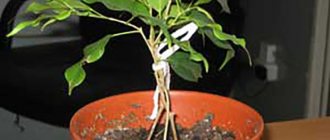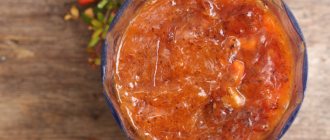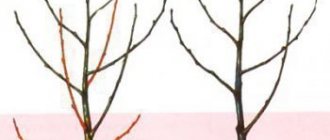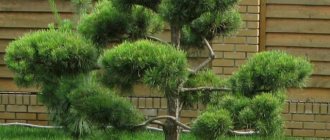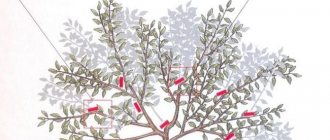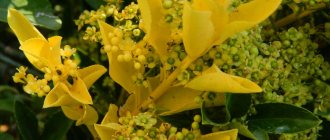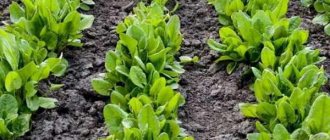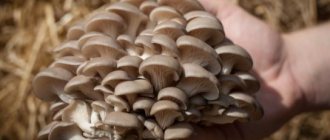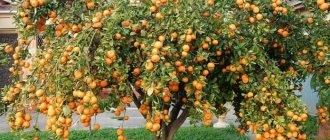The essence of the procedure
Pruning persimmons is a procedure that must be carried out in your garden every year and do not forget to do this in winter or early spring. This procedure is carried out in order to correctly form the crown, since in the initial period it is the one that is formed first, and after that the plant enters the fruiting stage.
The main purpose of pruning persimmon is to form a crown, which in the future will be responsible for the harvest and its quality. It ensures the correct location of the branches, along the entire length of which beautiful and juicy fruits will be located.
The tree will not be exposed to gusts of wind, which can break weak branches and negatively affect development. The second important goal, already for mature trees, is rejuvenation, since every year the plant ages, the branches become very dense and do not allow new ones to sprout.
To renew the tree, rejuvenating pruning is performed. It consists of removing old branches to form green mass.
Rules of care
During the process of growth and development, young trees require proper and timely care.
- Throughout the growing season, the plant is periodically watered. The first moistening is carried out in early spring, then watering is carried out before and after flowering. This crop is also moistened during the formation of ovaries, which has a beneficial effect on the quality of the crop. The last watering is necessary in the fall - a month before the onset of cold weather.
- This culture responds well to fertilizing. In the second half of summer, the tree is fertilized with phosphorus-potassium preparations. At the end of summer they are applied by foliar method. A solution is made from three components - potassium sulfate (0.5%), superphosphate (aqueous extract 0.5-1.5%) and potassium permanganate (0.02-0.05%). Spraying is carried out every week with a gradual increase in concentration to the maximum value.
- Loosening increases soil aeration and improves oxygen access to the roots. This procedure is carried out 1-2 days after each watering.
How long after planting is the crown formed?
The pruning stage of persimmons should begin 2-3 years after planting. Many gardeners make a big mistake during this period, because they see the first fruits and believe that there is no need to engage in its formation.
This is a wrong approach that leads exclusively to negative consequences. Of course, the tree will bear fruit, but not in such quantities and not in the same quality as most owners of this unusual tree would like.
Choosing a landing site
What is needed for this? First of all, you need to select a site suitable for growing subtropical crops - in a place well lit by the sun and protected from the winds (you can fence it off with forest belts or a high fence).
The occurrence of groundwater should not be higher than 3 m to the surface. Choosing the right site is the key to success. Areas located in places where cold air collects, on northern and eastern slopes, in ravines, in saline, swampy river floodplains, are not suitable for southern crops.
Read also: Lespedeza bicolor growing from seeds
The best areas are hills with southern, southwestern exposure or plains, which are less exposed to autumn and spring frosts
Procedure for crown development and rejuvenation - what is the difference?
In the first years, the formation of the tree’s crown begins so that it looks well-groomed and the gardener does not have problems in the future. A crown of strong branches is necessary so that the tree does not break under the weight of the fruit, can easily withstand strong gusts of wind, and allows persimmons to ripen evenly and correctly.
Pruning makes it possible to regulate the fruiting process, making it regular and stable.
Anti-aging pruning is carried out in order to stop the aging process of the tree. The cut must be made at such a height that the remaining part contains several buds, otherwise the tree will not be able to grow green mass again. You need to ensure that the cut is smooth and clear, leaving a small neat stump from which shoots will grow in the future.
Over time, the crown also requires renewal, because the tree grows every year. This process occurs in two stages:
- First, part of the skeletal branches on the south side is trimmed, simultaneously shortening small branches.
- The second stage begins two or three years later.
Everyone does the same on the north side. Thus, the crown of the tree is gradually renewed, the density of branches disappears, and the lower tier of small branches acquires nutrition and the ability to bear good fruit. It is very important to update the crown in two stages only if the trunk is healthy.
Grafting and pruning Persimmon
Every year, many consumers discover and appreciate the benefits of this product. Having tried it once, it is difficult to resist the temptation to enjoy it again and again.
Today, more and more gardeners prefer to plant new exotic crops on their plots, which include persimmons.
Those who can only afford to buy persimmons at markets or in stores come up with different ways to help preserve them for as long as possible, prepare them for future use, and delight their family and friends with this delicacy all year round. Anyone who loves gardening prefers to grow this sunny berry on their own.
The best seedling is no higher than 120 cm.
When planting, pruning is carried out at a height of up to 80 cm. Thus, a balance is created between the crown and the root system, and skeletal branches are laid.
The gardener's task when pruning a persimmon tree is to correctly form the crown. One of the effective ones is the sparse-tiered crown formation system , which consists of reducing the height of the tree itself and the number of crown tiers.
To do this, you need to thin out the crown from the inside, this will give the opportunity to develop skeletal branches. It is necessary to promptly remove emerging branches that retard the growth of the central conductor and the main skeletal branches.
The central conductor should be cut to a bud, which will ensure its vertical growth. It is advisable to leave 3-4 skeletal branches of the 1st order (7-10 cm between them) so that they are evenly located around the circle of the trunk. The branches of the 2nd tier are placed between the branches of the 1st.
Step-by-step instruction
For spring
How to properly prune branches in spring?
It should be borne in mind that persimmon can be grown either as a tree or as a bush. In the first case, it develops to a height of 12 meters, and as for the bush, its growth stops at about 4 meters. Experts advise taking the first step towards the correct formation of the tree the next spring after planting, cutting off the top at a height of 80 cm from the root collar.
This will create a balance between the crown and the root system, in which skeletal branches are formed during this period. This ends the first stage of pruning, and it will continue next year.
After a year, it is necessary to select 3 or 4 branches of the skeletal row, which will become the basis of the future fruit-bearing tree, with the correct system of arrangement of branches. The remains are completely removed, and you need to deal with not only the branches, but also the buds.
Two buds are left on the central shoots, and 5 buds will grow on the thin shoots. There are many types of crowns, but for persimmons the palmette system is well suited, which involves reducing the height of the crown and the number of tiers of branches.
Pruning is carried out from late autumn to early spring. In the spring it is good to work on the formation of a tree, since the wounds quickly heal and the tree returns to normal in a short period of time.
For autumn
Further pruning is carried out during the fruiting phase, and then the young growth in height up to 2 lateral buds is removed.
You need to prune persimmons every year in the fall or early spring, creating a new tier of branches, leaving a meter from the previous one.
Growing conditions and care
Grown sprouts should be planted in open ground the following spring, before active growth begins. A young persimmon plant requires regular watering in its first year to form healthy roots. In the future, persimmons will grow well without additional watering. This is provided that there is enough natural precipitation in your area.
3-4 years after planting, the persimmon begins to bear fruit. If a tree becomes overloaded with fruit, the tree may drop its fruit. To prevent this from happening, after the fruits have grown a little, you need to prune them, leaving only one fruit on each fruit-bearing shoot. As a result, you will get a good harvest. Caring for a persimmon tree also includes spring and autumn digging and loosening of the soil. Every year, whitewash the trunk and bases of the skeletal branches of the tree.
Caring for persimmons is simple
Persimmon is a light-loving crop that grows well in fertile, moisture-intensive, well-drained soils. But in heavy and saline areas, trees quickly age, weaken and are affected by diseases.
On the territory of our country, a more winter-hardy species of this plant is grown in open ground - Virginia persimmon and varieties obtained on its basis. And yet, for planting the plant, a place protected from the wind and sufficiently moist is chosen; the best option is near the wall of the house. Seedlings can be purchased, or you can grow yourself from seeds.
The purchased seedling must be immediately planted in the soil. The planting hole should be 20 cm larger in diameter than the root system of its new plant. When planting, the root collar of a seedling is deepened by 8-11 cm on heavy soils and by 12-16 cm on light soils. After planting, it is not recommended to trample the soil around the seedling; it will settle on its own, and later, if necessary, it can be added and watered.
The soil for planting persimmons is prepared in the same way as for planting other fruit crops. The planting pattern for vigorous species is 7×7 m, for low-growing species – 3×3 m.
Persimmons have three types of flowers: male, female and bisexual. Females are usually large, single; male ones are smaller and located three on a branch. Persimmon varieties with female flowers require pollinators. Moreover, one tree with male flowers can pollinate five to seven trees with female flowers.
The plant can be grown as a bush or tree. The tree reaches a height of 10-12 m, the bush - only 3-4 m. To form a persimmon tree, seedlings are pruned in the spring at a height of 80-90 cm from the root collar. In the second year, three or four skeletal branches of the first order are selected from the grown lateral branches, the rest are cut into a ring. Depending on the thickness of the shoot, two to five buds are left on the skeletal branches. The central conductor is cut to a bud that ensures vertical growth.
In the third or fourth year, the tree can already bear fruit. On branches of the first order, branches of the second order grow. There should be no more than two of them, and they should be located on the sides. In this case, the second tier of skeletal branches is formed between the branches of the first tier at a height of 60-70 cm from them.
In the fourth or fifth year, the next, third, tier is created at a height of 50 cm from the second.
A tree with a properly formed crown is usually well developed, and in the future it is enough to simply thin it out.
Persimmon shoots are divided into three groups: up to 10 cm; 25 cm - they give the main harvest; 30 cm or more are fatty shoots that should be shortened by half. Persimmon bears fruit on annual growths, so it is precisely these annual shoots that you should try to get a sufficient amount of.
During annual sanitary pruning, broken, damaged, dry branches and branches extending into the crown are removed. When shoot growth and fruiting decline, rejuvenating pruning is carried out: two- and three-year-old branches that bear fruit are cut out. This technique enhances the growth of shoots, fruiting shifts to the base of the skeletal branches. Cutting branches up to three- and four-year-old wood is carried out every two to three years.
Partial rejuvenation is carried out at the age of 15-20 years. The degree of pruning of old wood depends on the characteristics of fruiting. Trees with a pronounced periodicity of fruiting are pruned heavily, and annual growths are thinned out and shortened. The main pruning is carried out in the spring, and in the summer branches with weakened growth are pruned.
Persimmons should be watered taking into account precipitation. Young trees need to be moistened every 10-14 days, adults – after three to four weeks. The soil should not become waterlogged, otherwise the fruits may fall off.
In the first three years of the plant’s life, fertilizers are applied to the tree trunk circles at a distance of 50-80 cm from the trunk. Trees older than eight years are fed according to the projection of the crown. The rates and types of fertilizers are the same as for other fruit crops. For a tree between two and five years old, 10-15 kg of organic matter will be needed, for a plant between six and ten years old, 15-20 kg will be enough; An 11-15 year old persimmon will need 20-25 kg of organic fertilizer just right. They are introduced every four to five years. But every year during the growing season the soil should be loosened four to six times.
In the winter, tree trunks must be insulated and hilled up to protect them from freezing, and in the spring they must be whitewashed to protect against burns. With a large harvest during its ripening period, it is useful to put supports under the branches.
Landing of the "Rossiyanka"
Before planting, you need to take care of purchasing the seedlings themselves. They can be bought in online stores or in nurseries. You should not buy seedlings secondhand, because you may end up with something completely different from what you expected.
The seedling should not be older than two years of age - older ones run the risk of not being able to tolerate the transplant; the plant may simply not adapt and not take root.
- Before planting in open ground, the roots of a young seedling should be placed in a container of water for several hours.
- It must be taken into account that groundwater should be located no closer to the surface of the earth than 70 - 80 cm. Strong waterlogging promotes the development of additional shoots, and not the growth of the tree itself. The depth of the root in the soil usually does not exceed half a meter if the seedling is one or one and a half years old.
- If you are just trying to plant persimmons in your garden, it is better to choose a place on the south side or near the wall of the house, which will protect the tree from winds and drafts. The place should be sunny and dry; in the shade, persimmons do not develop well, and you may not expect a harvest at all.
Planting is carried out in the spring, mainly in regions with harsh winters and cold autumns. In warmer areas, seedlings can be planted in the autumn.
Preparing the site and soil before planting
Every gardener needs to prepare a site for planting a seedling in advance. The following steps are required:
- The soil for the seedling is fertilized with peat and thoroughly loosened. It should be light in structure and allow air to pass through well. In terms of composition, preference is given to slightly acidic soil.
- Immediately before planting, it is necessary to dig a hole with a depth and a diameter of 60 cm. Soil is placed at the bottom, to which it is recommended to add manure and river sand in equal parts. The hole should be left to ventilate for a while and the ground should be allowed to warm up.
- When planting, to protect the young tree, a small support is placed in the ground so that the trunk does not break from the wind.
- Only two days after the planting hole has been ventilated, the seedling is lowered into the hole and the soil around the trunk is compacted a little. Then pour water at room temperature. The area around the trunk is covered with leaves and dry grass so that the seedling takes root and successfully goes through the adaptation period.
After planting a persimmon bush, you should follow some simple rules for further care. While growing a seedling to the state of a mature tree, your attention and care will be needed.
Growing persimmons at home
We all want to have something outlandish in our garden, something that our neighbors don’t have; I am especially attracted to exotic fruits brought from distant southern regions. For the northern slope of the Crimean Mountains, where our nursery is located, the dream of growing our favorite fruit - persimmon - has always seemed unrealistic.
However, science does not stand still, and quite recently, from the crossing of eastern and Virginia persimmons, an interspecific hybrid appeared , which was called hybrid persimmon. The result is stunning. After a harsh winter with frosts down to -27 degrees and April frosts of seven degrees, almonds and peaches simply did not bloom, cherry plums, apricots and cherries froze, many varieties of grapes did not produce a harvest , and persimmon, this subtropical guest, is bursting under the load of golden fruits. More than half of the leaves have already fallen off, garlands of bright orange balls have become clearly visible - neighbors ask why they hung tomatoes on the trees, and children shout: “Mom, mom, look how many apricots!”
The fruits stick to the tree very tightly; when harvesting, they have to be cut off with pruning shears, and those that were not removed will shine like New Year's lanterns from a height until mid-winter, attracting birds with their delicate pulp. Unlike imported persimmons, which, when fully ripe, have a slightly watery, as if unfinished taste and a semi-liquid consistency - like a pickled tomato, you can simply suck it out of the peel - Crimean fruits are very sweet, unusually tasty, their pulp looks like thick jam and has a unearthly aroma. Drying from them turns out fantastic, but, as our teacher V.P. Chernyaev, very unprofitable: no matter how much you give, they will immediately eat it and ask for more. Jam and candied fruits are in no way inferior in taste and aroma to dried fruit.
Persimmon planting technology
After purchase, seedlings should be planted as quickly as possible, grafted to the south. The root collar is deepened by 7-10 cm on heavy soils and by 10-15 cm on light soils. The soil around the seedling should not be trampled down - you can add soil after subsidence and water it abundantly. The soil for planting persimmons is prepared in the same way as any other fruit crop. The dimensions of the planting hole depend on the size of the root system - the hole should be 20 cm larger than their diameter. The planting pattern for tall varieties is 7x7 m, for short varieties - 5x3 m, for thickened plantings - up to 3x3. One male plant is enough for 8 female plants.
In our conditions, it is preferable to plant in the fall . The soil does not freeze deeply; during the winter, plants have time to heal damaged roots and form young suction roots that will provide the tree with moisture during spring dry winds. When planting, you need to thoroughly compact the soil around the roots and water it abundantly so that there are no air voids left in the soil and the seedlings do not dry out. After absorbing water, young plants should be hilled up high, insulating the grafting site so that in the event of a very frosty winter, the seedlings weakened by transplantation do not freeze. Under such conditions, the trees tolerate winter well and take root well.
Over the course of many years, persimmons use a supply of nutrients from the same volume of soil. Therefore, for active growth and obtaining full yields, plants must be fed. In the first two to three years after planting, fertilizer is applied to the tree trunk circles, at a distance of 50-80 cm from the trunk. And after eight years - according to the projection of the crown.
Experiments with Russian persimmon
Gardeners are restless people who love to experiment and try something new. In the case of persimmons, this is also possible. It is also possible to plant persimmons independently from a seed. Actually, the principle is the usual, drying, stratification, planting persimmons in the ground and abundant watering. The only “but” is that it is better to grow a houseplant from a seedling and regulate its height at 1.5 meters. It also does not enter the fruiting period for a long time. To speed up the process, you can graft the seedling. True, in this case the tree will turn out to be of a height generally accepted for a rootstock. It makes no sense to describe the grafting process, since it is standard. Numerous experiments have shown that persimmon grows only on its own rootstocks. Therefore, you should think about it yourself, for example, purchase it from a botanical garden. Persimmons are grown in almost all regions, so there shouldn’t be any problems. Try, experiment, share your experience, including on our forum, and be happy!
Pruning and shaping the crown of persimmon
Young plants are pruned at a height of 80-90 cm from the root collar. From the emerging side shoots, 4-5 skeletal branches are formed, the lower of which should be at a height of 50-60 cm from the root collar. In the next season, future skeletal branches are cut to 35-40 cm. In the same year, fruiting may begin, after which the persimmon cannot be pruned too much. Pruning should stimulate the formation of a sufficient number of new annual shoots on which fruits are formed. Sanitary pruning of persimmons is carried out annually, and rejuvenating pruning begins when shoot growth noticeably decreases. In the year of anti-aging pruning, the tree usually does not bear fruit.
Harvest and storage of persimmons
A few years after planting a young tree, the first fruiting can be expected. But there will be a full harvest only in the fifth year of active persimmon growth, as well as with proper care.
You need to know that usually the first flowering of a tree is reset. You should not be afraid of this, but, on the contrary, it indicates that the seedling has taken root correctly and is gaining strength for the subsequent full harvest.
Harvesting is done manually. The fruit should be carefully rolled on the stalk so as not to damage the delicate skin. Since persimmons are not stored for long - about a month, the fruits can be frozen and then used both raw and for making preserves and jams.
Frozen storage will not negatively affect the taste of the fruit. It remains just as aromatic and tasty.
Such an exotic tree can not only provide your family with vitamins during the cold season, but will also become a real decoration for your garden. When all the trees have long since bloomed and dropped their leaves, and the harvest has already been harvested, the persimmon will stand out with its bright color until winter.
Persimmon propagation
The methods and timing of persimmon propagation are similar to many fruit trees, but it also has some peculiarities. The sap of persimmon wood contains a lot of tannins, therefore, due to oxidation in air, a thin film is formed between the rootstock and scion, which prevents their fusion. Few people have been successful in this matter. It turned out that the secret of successful grafting was hidden in the budding knife. If this is an ordinary knife, then when it comes into contact with wood, the metal instantly oxidizes the cut areas. If you use a stainless steel knife, success is guaranteed. The vaccination period is the end of February – March.
The entire persimmon trunk is literally strewn with dormant buds invisible to the eye. Therefore, any tree, even an adult one, can be regrafted onto a new variety. To do this, all skeletal branches are removed, the wounds are cleaned, especially along the edges. From one to four cuttings are inserted into each stump, tightly tied with a film 2-4 cm wide and the cuts are coated with garden varnish or plasticine. The bud and cuttings are tightly fixed for a month. As the grafts thicken, care must be taken to ensure that the binding material does not cut into the bark.
Caring for seedlings: temperature conditions, feeding
Persimmons from seeds usually germinate well at home, but sometimes shells remain on young shoots, which are difficult for the plant to get rid of on its own. In this case, you need to act like this:
- Moisten the seed with water and cover the pot with a bag overnight. The next day, remove the shell using a knife or tweezers.
- Moisten a piece of cloth by wrapping it around the bone for several hours. Once softened, the shells will fall off.
As soon as Diospyros has real leaves, the pot is placed on a well-lit windowsill. You just need to make sure there are no drafts. Further cultivation of persimmons at home involves maintaining optimal heat and light conditions, watering, and fertilizing.
First sprout
Persimmon is a heat-loving plant, so the temperature in the room where it is located should not be lower than +17°C. The exception is the winter period, when Diospyros goes into a dormant state. When the leaves fall, the young tree is transferred to an unheated corridor or lowered into a cellar with a temperature of +12 to +5°C. The soil is covered with sawdust and moistened twice during the cold season to prevent the roots from drying out.
The tree loves light, so you need to choose a well-lit place for it in the house. At the same time, direct sunlight can leave burns on the leaves. Therefore, if in the summer it is possible to take persimmons outside, you need to gradually accustom them to the open air. First, the pot is placed in the garden or on the balcony in the late afternoon (in cloudy weather) for several hours. Then the time of diospyros exposure to air is increased. In this case, during the first days the tree is shaded from the south side and the watering rate is increased.
Persimmon is a long-day plant. In spring and autumn it is illuminated for 2-3 hours.
Oriental apple does not tolerate both lack of water and waterlogging of the soil. Therefore, it is watered often, but moderately and only with warm water. In hot weather, the tree is additionally sprayed several times a day. From mid-autumn, the watering rate is reduced.
Details of cultivation and care in the video.
Under natural conditions, Diospyros grows in poor soil without any fertilizer. Persimmon from a seed planted in a pot needs feeding. The plant is fertilized for the first time at the age of 2 months. For this, 0.5 tbsp. l. wood ash is poured into 500 ml of boiling water. When the mixture has cooled, another 250 ml of warm water is poured into it. After this, the tree is fed every 2-4 weeks after watering, alternating organic and mineral fertilizers.
Fertilizer (especially organic) for homemade persimmons is given in limited quantities. Otherwise, the roots will not be able to provide the necessary nutrition to the overly powerful green mass. From the end of October to the beginning of April, feeding is completely stopped.
Transplantation and crown formation
To prevent the plant’s root system from being inhibited, it must be replanted periodically. Transfer times:
- For the first time, persimmons are transferred to a new place at the age of 3 months.
- The second transplant is done when the seedling reaches a height of 35-40 cm.
- From the second year of life, Diospyros needs a new pot every six months.
Stages of growth - From the 3rd year, the container is changed once a year.
- A five-year-old or older plant is replanted no more than once every 2 years.
The diameter of each new pot should be no more than 3-4 cm larger than the previous one, otherwise the tree will grow greatly and will not bear fruit. Before transplanting, moisten the soil under the tomato tree. The plant is transferred to a new container along with a lump of earth so as not to damage the thin roots. After this, the voids in the pot are filled.
A young tree is transplanted only during the warm period. It is recommended for an adult plant to change its place of residence in early spring. An oriental apple older than 5 years, growing in a 20-25 liter pot, no longer needs to be replanted. It is only necessary to periodically replace the depleted top layer of soil with a more fertile one.
Numerous photos of homemade persimmons show that it has a compact spherical crown. This formation is carried out not only for aesthetic, but also for practical reasons. On shoots that are too powerful, fruit buds do not form.
Video about the formation of a fruit tree.
Before you correctly form the crown of dyspyros, you need to pay attention to several recommendations:
- When 4-5 leaves appear on the seedling, pinch it. This procedure stimulates the growth of side shoots. When the same number of leaves forms on the shoots, they are also pinched.
- Gradually, the crown is given a spherical shape, pinching overgrown branches as necessary.
With proper care, a compact plant up to 1.5 m tall is obtained.
How to make a tree bear fruit?
The proper amount of time must pass from planting to crown formation. Let's find out how a tomato tree grows at home. Under comfortable conditions, this happens quickly, but you will have to wait 7 years for flowers and fruits. Is it possible to speed up the moment of fruiting? Yes, if you vaccinate and use “moderate restriction agricultural practices.”
When the trunk diameter is 4-5 mm, it can be grafted in two ways.
- kidney,
- cutting using the “split” method.
Grafting into cleft
Persimmons are grafted in early spring, before sap flow begins. If the vaccination is done later, the graft will most likely not take root. Diospyros juice oxidizes the cuttings, a film is formed on them, preventing the fusion of the cuttings or buds with the rootstock. Grafted plants bloom 3 years after the procedure.
In addition to grafting, external conditions influence fruiting. If the plant's life is too comfortable, it will not produce fruit buds. Therefore, it is necessary to periodically create stressful situations for him, namely:
- feed only in small doses;
- do not replant into a pot that is too spacious;
- do not let the crown grow too much;
- during the rest period, maintain at a temperature not exceeding +12°C.
Persimmon varieties with photos and descriptions
Persimmon King
Korolki are a group of persimmon varieties.
The persimmon develops from a female flower, and the wren develops from a male flower. Kings, as a rule, do not have an astringent taste; they are dark orange in color with brown flesh (for which it is also called chocolate). But there are also light greenish-yellow firm fruits. However, even the well-known variety of wren can be different. If pollination has occurred and seeds have formed, the brown kinglet ripens - strong, sweet and tasty. But there was no pollination - a bright orange fruit with viscous pulp is born. The appearance of this marriage is associated with pollination problems that arise for various (weather) reasons. Such fruits will never become tasty and soft. Moreover, their taste no longer depends on the period of ripening: early-ripening, mid-ripening, and late-ripening varieties can be tart. Chocolate persimmon fruits, picked unripe when they are still hard, turn brown and become softer after a few days. To do this, they need to be placed for several days in a warm, protected place, but not in the sun.
Persimmon Ox heart
A very tasty variety of persimmon, very large and seedless. It really resembles the shape and size of huge Bull's Heart tomatoes. The flesh of this persimmon is always orange in color and does not darken when ripe, but it becomes very soft and tender. Ripe tomato persimmon is also difficult to transport as the above mentioned honey persimmon. A very sweet variety of persimmon, but not as sugary as Honey.
Honey / tangerine
It’s not for nothing that these persimmons were given such names. It is tangerine because its shape repeats the shape of a tangerine, and honey - to taste. This is the sweetest variety of persimmon, it is often even cloying. You eat a few pieces and it’s impossible to eat any more because of its strong sweetness. This persimmon never has seeds, and the flesh is always bright orange; when the fruit is fully ripe, it becomes a jelly-like consistency, liquid. This persimmon is very delicate, and when it is ripe, it is not transportable at all, it is even impossible to carry it in a bag.
Description
In areas with suitable soil and climate, persimmons are grown in open ground. It can reach a height of 10 to 30 meters. In appearance it resembles an apple tree. The alternate leaves have a dark color on the outside of the plate and a lighter color on the inside. In autumn they glow in different shades of red.
Read also: What to make from old leather bags
Yellowish-white flowers located in the leaf axils can be formed into one of three types׃
Flowering begins in May and ends by June.
Persimmon berries can be the following colors׃
They have a slightly tart flesh that becomes very sweet when ripe. The fruits weigh from 100 to 500 grams.
How to grow persimmon from seed
Persimmon is called the “plum of the gods” for its orange fruits. How wonderful it is to go out into the garden and pick a persimmon fruit right from the branch.
It’s a pity that persimmon grows only in the southern regions of our Motherland, and most of us can only taste it by buying it in a store. But recently, many exotic lovers have appeared who grow persimmons (and other southern plants) on their windowsills, claiming that there is nothing complicated in this matter.
This is what Maxim Valentinovich Markin says, who not only grew persimmons at home in Krasnoyarsk, but has already managed to taste the first fruit.
I didn’t plan to plant my own persimmon tree on purpose; it happened completely by accident. One day, my youngest granddaughter Veronica and I were walking around the market, and when she saw a persimmon, she asked to buy it. Was it really possible to refuse, they did.
Description of the Russian variety
Persimmon Rossiyanka, despite the name, was bred in 1959 on the territory of the Ukrainian USSR. The Crimean Nikitsky Botanical Garden became its homeland. The name is most likely due to the fact that frost resistance down to -28–30°C (according to some gardeners even down to -35°C) allows this persimmon to be grown not only in its usual subtropics, but also in the temperate Russian climate, even in latitude of the Moscow region.
There are not so many frost-resistant persimmon varieties that can be grown not only in warm southern regions; Russian woman is one of them
The Russian woman is a hybrid. Therefore, it does not reproduce by seeds, but fruits are set, regardless of what gender the tree is. The variety is considered self-fertile, but the presence of nearby pollinators (one per 8–10 persimmon trees) has a positive effect on the taste and softness of the pulp.
Universal pollinator - a fruit-bearing variety bred specifically for pollinating eastern, Virginia and hybrid persimmons
Appearance of tree and fruit
The average height of the tree is 4–5 m. But in favorable conditions it can grow up to 6 m. The crown is spreading and wide. The shoots are densely leafy.
Russian persimmon is a fairly tall tree with a spreading crown; when planning to plant it, consider whether you have enough space on your plot
Flowering occurs at the beginning of June. The flowers are pastel pink, the petals are slightly “curly”. In the first year, the tree drops all its flowers, this is normal.
The flowering of persimmons cannot be called a bright spectacle, but the flowers look quite nice
The persimmon is medium-sized, weighing 60–70 g. The fruits are bright orange, symmetrical in shape (round or slightly flattened), almost seedless. The whitish waxy coating on the skin disappears as it ripens. Ripe persimmons have a wonderfully sweet taste.
It is easy to determine whether a Russian persimmon is ripe or not by the presence of a waxy coating on the fruit
Video: what Russian persimmon looks like
Frost resistance and other pros and cons of the variety
Among the undoubted advantages of the variety are:
There are also disadvantages:
- large dimensions of the tree;
- high rates of shoot growth.
